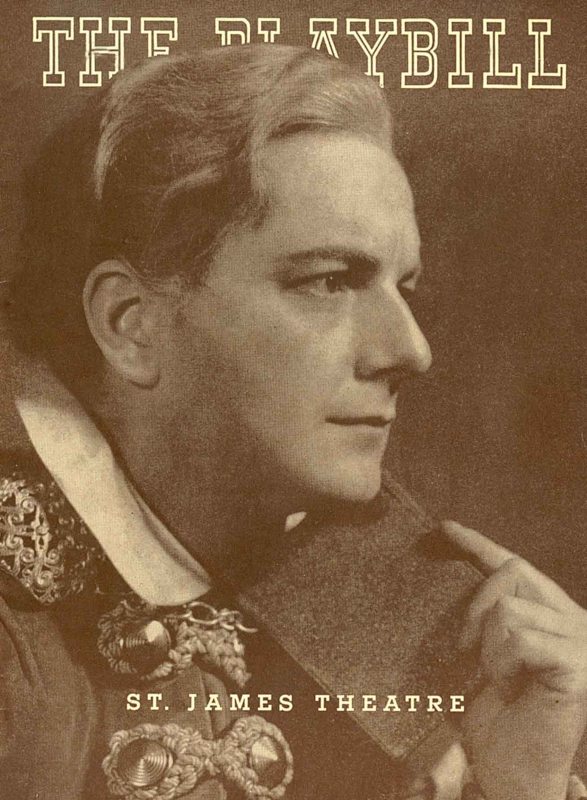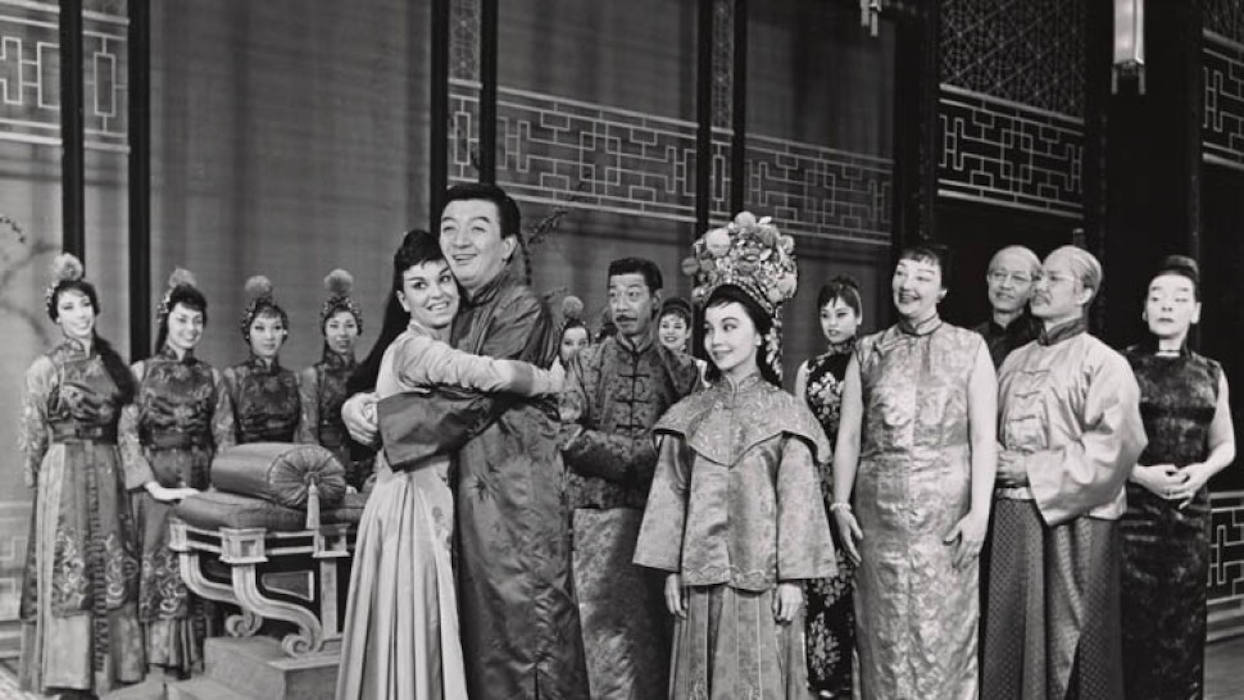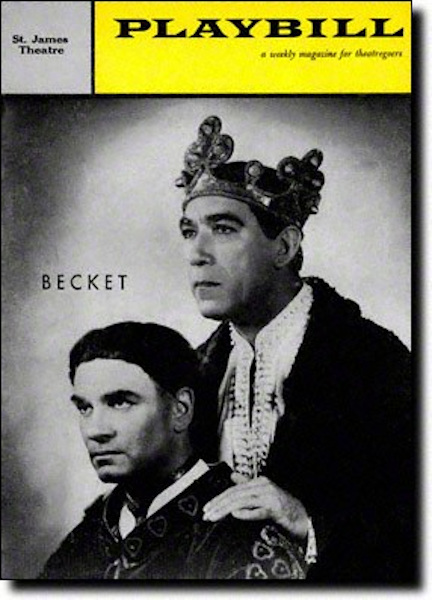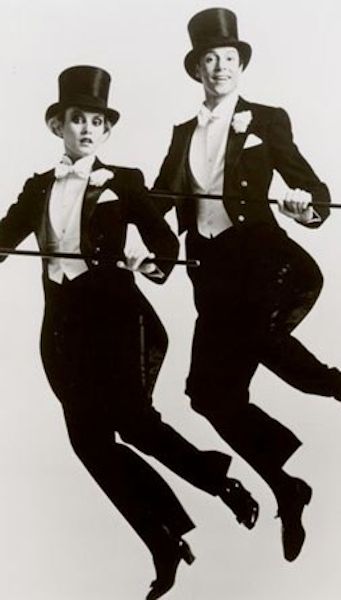
St. James Theater (originally Erlanger Theater)
overview
Opened as the Erlanger Theater in 1927 and renamed the St. James Theater in 1932, this venue has staged multiple productions involving major LGBT performers and creators, including Jerome Robbins, Florence Klotz, Oliver Smith, Cole Porter, Arthur Laurents, Nathan Lane, Laurence Olivier, Irene Sharaff, and Katharine Hepburn, among others.
Three hugely successful musicals at the St. James with LGBT associations were Oklahoma! (1948), The King and I (1951-54), and Hello, Dolly! (1964-70).
History
Erlanger Theater
This venue opened as the Erlanger Theater in 1927. One LGBT- associated play here was Murray Anderson’s Almanac (1929) by Noel Coward and others, and with actor Jack Cole.
St. James Theater
The name was changed in 1932 to the St. James Theater. There were multiple big LGBT-associated hits here:
- Panama Hattie (1941), with music and lyrics by Cole Porter (opened at the 46th Street Theater)
- Oklahoma! (1943-48), based on the play Green Grow the Lilacs (1931) by Lynn Riggs, and with costume design by Miles White, and with actor Lee Dixon
- The King and I (1951-54), with costume design by Irene Sharaff (Best Costume Design Tony Award) and choreography by Jerome Robbins
- Flower Drum Song (1958-60), with scenic production by Oliver Smith, and costume design by Irene Sharaff
- Hello, Dolly! (1964-70 – Best Musical Tony Award) by Michael Stewart (Best Author of a Musical Tony Award) based on the play The Matchmaker by Thornton Wilder, with music and lyrics by Jerry Herman (Best Composer and Lyricist Tony Award), scenic design by Oliver Smith (Best Scenic Design Tony Award), costume design by Freddy Wittop (Best Costume Design Tony Award), and with actor Charles Nelson Reilly
- Barnum (1980) by Mark Bramble, directed by Joe Layton, and with lyrics by Michael Stewart
- My One and Only (1983-85), with staging and choreography by Tommy Tune and Thommie Walsh (Best Choreography Tony Award), with Tune (Best Actor in a Musical Tony Award)
- 42nd Street (1987-89; opened at the Winter Garden Theater) by Michael Stewart and Mark Bramble, with lighting design by Tharon Musser
- Gypsy (revival, 1989-91) by Arthur Laurents, with lyrics by Stephen Sondheim (Best Revival Tony Award)
- A Funny Thing Happened on the Way to the Forum (revival, 1996-98), with music and lyrics by Stephen Sondheim, and with actor Nathan Lane (Best Actor in a Musical Tony Award)
Productions by LGBT creators and with LGBT performers at the St. James included:
- Walk a Little Faster (1932-33), with actor Beatrice Lillie
- Ballet Russe de Monte Carlo (1933), its American debut, with dancer Leonide Massine
- Thumbs Up! (1934-35), with scenic and costume design by Raoul Pene Du Bois and others
- May Wine (1935-36), with actor Jack Cole
- Hamlet (revival, 1936-37), staged by Guthrie McClintic, with actors John Gielgud, Judith Anderson, and Harry Andrews (opened at the Empire Theater)
- King Richard II (revival, 1937), with actor Maurice Evans
- Hamlet (revival, 1938), with actor Maurice Evans
- Henry IV (revival, 1939), with actor Maurice Evans
- Twelfth Night (revival, 1940), with actor Maurice Evans
- Pal Joey (1941), with lyrics by Lorenz Hart, and with actor Van Johnson (opened at the Barrymore Theater)
- Sunny River (1941-42), with costume design by Irene Sharaff
- Without Love (1942), with actor Katharine Hepburn
- Peter Pan (1950), with music and lyrics by Leonard Bernstein, and with actor Jean Arthur (opened at the Imperial Theater)
- Once Upon a Mattress (1960; opened at the Phoenix Theater), co-authored and lyrics by Marshall Barer
- Becket (1960), with scenic design by Oliver Smith (Best Scenic Design Tony Award), and with actor Laurence Olivier
- Do Re Mi (1960-61), with costume design by Irene Sharaff
- Subways Are for Sleeping (1961-62), with costume design by Freddy Wittop, and with Michael Bennett as a dancer
- Luther (1963-64), directed by Tony Richardson
- A Streetcar Named Desire (revival, 1973) by Tennessee Williams
- The Misanthrope (revival, 1975), directed by John Dexter, and with actor Alec McCowen
- A Musical Jubilee (1975-76), with actor Cyril Ritchard
- My Fair Lady (revival, 1976), with production design by Oliver Smith, costume design by Cecil Beaton, with W. Robert LaVine as special costume assistant, and with actor George Rose (Best Actor in a Musical Tony Award)
- On the Twentieth Century (1978-79), with costume design by Florence Klotz
- The 1940’s Radio Hour (1979-80), with musical staging by Thommie Walsh, costume design by William Ivey Long, and lighting design by Tharon Musser
- Filumena (1980), a production by Franco Zeffirelli, directed by Laurence Olivier
- Jerry’s Girls (1985-86), with music and lyrics by Jerry Herman, costume design by Florence Klotz, and lighting design by Tharon Musser
- High Society (1998), with music and lyrics by Cole Porter
- The Civil War (1999), with costume design by William Ivey Long
- Swing! (1999-2001), with costume design by William Ivey Long
Entry by Jay Shockley, project director (June 2019, with multiple additions).
NOTE: Names above in bold indicate LGBT people.
Building Information
- Architect or Builder: Warren & Wetmore
- Year Built: 1926-27
Sources
“The 1st List of: Gay/Lesbian/Bi Industry People, Both in Front and Behind the Camera,” www.imdb.com, May 31, 2013.
Adam Hetrick, “The Work of Broadway’s Gay and Lesbian Artistic Community Goes on Display Nov. 14 When the Leslie/Lohman Gay Art Foundation Gallery Presents ‘StageStruck: The Magic of Theatre Design’,” Playbill, November 14, 2007.
Erlanger Theater Designation Report (New York: Landmarks Preservation Commission, 1987).
Internet Broadway Database.
Do you have more information about this site?
This project is enriched by your participation! Do you have your own images of this site? Or a story to share? Would you like to suggest a different historic site?








